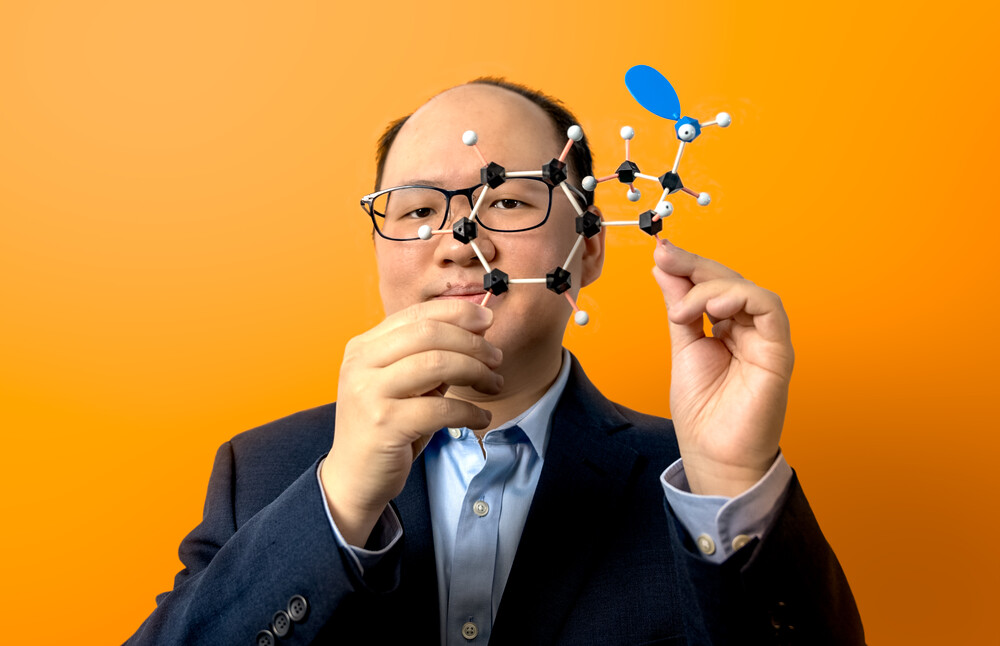
‘Personally, I believe two of the most important driving forces in the field of chemistry are passion and imagination.’
 Professor Zhongxing HUANG
Professor Zhongxing HUANGAssistant Professor of the Department of Chemistry
- 2024 Outstanding Young Researcher Award (HKU)
- 2023 Chinese Chemical Society Prize for Young Scientists
- 2023 NSFC Excellent Young Scientists Fund (Hong Kong & Macau)
- 2023 Thieme Chemistry Journals Award
- 2022 Research Output Prize (HKU)
- 2022 Asian Core Program Lectureship Award (Korea and Taiwan)
Research Interests:
Organic synthesis; asymmetric catalysis; transition metal catalysis; organocatalysis; conversion of renewable resources.
As global demand for efficient and environmentally friendly chemical processes intensifies, innovative chemistry holds the key to a sustainable, healthier future. Leading this transformative charge is Professor Zhongxing Huang, whose pioneering research in asymmetric catalysis is redefining the boundaries of chemical synthesis and pharmaceutical discovery.
Revolutionising the Field of Asymmetric Catalysis
Chirality, the property of molecules existing as non-superimposable mirror images (like left and right hands), is critical in pharmaceuticals, where often only one mirror image, known as ‘enantiomer’, is therapeutically effective or safe. Huang’s research harnesses asymmetric catalysis to selectively and efficiently produce these chiral molecules, eliminating wasteful separation processes and minimising byproducts.
‘This is where asymmetric catalysis truly shines,’ explains Huang. ‘By selectively producing the desired enantiomer, it not only reduces chemical waste and energy use but also promotes green chemistry practices while delivering significant economic and scientific benefits for drug discovery and manufacturing.’
A landmark achievement from Huang’s group was the development of reductive desymmetrisation methods for malonic esters (Nature Chemistry, 2021) and malononitriles (Nature Chemistry, 2024) — two essential building blocks in drug and material synthesis, produced in tens of thousands of tons annually. Controlling the chirality of their transformations has long been a challenge, previously dominated by costly and limited enzymatic catalysts.
‘For decades, researchers relied on enzymatic catalysts, which were expensive and often limited in scope,’ says Huang. ‘Our work overcame these limitations by developing innovative transition metal catalysts that are scalable, efficient, and versatile, enabling the production of over 30 bioactive compounds and inspiring researchers worldwide to tackle other longstanding challenges in asymmetric synthesis.’
Bridging Fundamental Chemistry and Practical Applications
The practical implications of Huang’s discoveries are profound. By offering highly selective, cost-effective methods for synthesising chiral molecules, his work directly advances drug discovery and manufacturing.
‘These catalysts are designed with real-world applications in mind,’ Huang remarks. ‘They streamline compound library generation, optimise synthesis processes, and reduce production costs, making them highly attractive to pharmaceutical companies.’
Several leading pharmaceutical companies, both domestic and international, have already expressed strong interest in adopting these novel catalysts, underscoring the immediate and transformative real-world impact of this research.
Leading a Special Force in Chemical Innovation
Huang leads a focused team of eight researchers, guided by a philosophy of strategic problem-solving and close collaboration. Emphasising daily communication and hands-on mentorship, his lab operates like a ‘special force’, tackling critical challenges in chemical research and paving the way for broader scientific advancements.
Huang’s lab has already achieved several milestones including the first reductive desymmetrisation of malonic esters, which broke a 30-year dependence on enzymatic catalysis through the use of a novel tetradentate ligand and dinuclear zinc catalysts. They also pioneered the reductive desymmetrisation of malononitriles, introducing an innovative ternary steric pairing strategy for enantiocontrol, and developed the first acid-catalysed asymmetric decarboxylation, enabling precise proton transfer to produce diverse chiral amino acids.
Looking ahead, Huang and his team remain committed to advancing catalytic methods and sustainable chemical processes, driving innovation that addresses both scientific and societal challenges.
‘We’re not just solving today’s problems,’ Huang reflects. ‘We’re building a foundation for a future where chemistry plays a central role in creating a healthier, more sustainable world.’
By bridging fundamental research with practical applications, Huang’s work aims to deliver impactful solutions to pressing global issues, from advancing healthcare to promoting environmental sustainability. With their dedication and vision, Huang and his team are poised to shape the future of chemistry for generations to come.
| < Previous | Next > |

